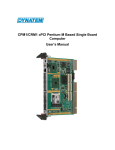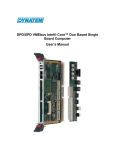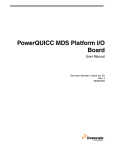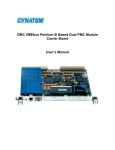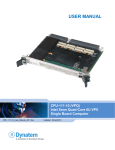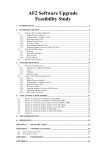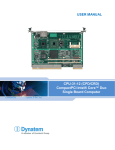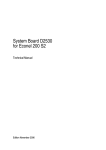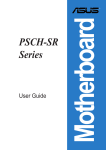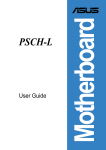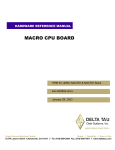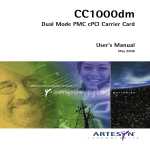Download C3PM/C3RM cPCI Pentium M Based Single Board
Transcript
C3PM/C3RM cPCI Pentium M Based Single Board Computer User’s Manual C3RM Manual Rev 1.06 March 17, 2008 Dynatem 23263 Madero, Suite C Mission Viejo, CA 92691 Phone: (949) 855-3235 Fax: (949) 770-3481 www.dynatem.com Table of Contents 1. Features 1 2. Related Documents 3 3. Hardware Description 5 3.1 3.2 3.3 3.4 3.5 3.6 3.7 3.8 3.9 4. Overview Processor Chipset DRAM Intel 82546EB Dual Gigabit Ethernet Controller PLX PCI6254 PCI-cPCI Interface Intel’s FW82802A Firmware Hub Holds the System BIOS In Flash Memory Clock Drivers Reset Circuitry 13 Installation 4.1 4.2 4.3 4.4 Dynatem 5 6 6 7 7 8 10 10 11 Installing C3PM in a CompactPCI Chassis Jumper & GPIO Selectable Options Discrete I/O vs. COM1 Line Routing CompactFlash Drive Installation C3PM cPCI Pentium Processor Board – User’s Manual 13 13 15 16 i A. A.1 A.2 B. B.1 B.2 B.3 Connector Pin-outs 17 CompactFlash Interface Connector (J2 on carrier card) cPCI Connectors (J1 & J2) Address Maps, Interrupts, DMA Channels Memory Map PCI Configuration Space Map Interrupt Request Routing 18 19 21 21 21 22 C. Power and Environmental Requirements 23 D. X3PMRIO Rear Plug-in I/O Expansion Module 25 ii C3PM cPCI Pentium Processor Board – User’s Manual Dynatem Chapter 1 – Features 1. Features The Dynatem C3PM is a single-slot 3U cPCI Single Board Computer (SBC). The C3PM offers full PC performance with a Pentium M low-power processor. The C3PM is available in two versions: the C3PM for standard industrial applications and the ANSI/VITA 30.1-2002 compliant, conduction-cooled CRM1 with wedgelocks, stiffener bar, and a full board heatsink for rugged applications. When referring to attributes of both versions, we will use the name C3PM. The C3PM employs Intel’s embedded technology to assure long-term availability. Features of the C3PM include: • Single-slot cPCI operation with on-board CompactFlash disk for bootable mass storage. • VGA graphics, two USB 2.0 ports, one Serial ATA port, two Fast Ethernet ports, and driven COM1 & 3 ports are routed out to the backplane via the J2 connector • The Intel® 855GME Graphics Memory Controller Hub (GMCH) and Intel® 6300ESB I/O Controller Hub (ICH) provide high-speed memory control, built-in graphics, integrated I/O including Serial ATA, USB 2.0, IDE supporting Ultra 100 DMA Mode for transfers up to 88.88 MB/sec, and 64 bit PCI-X bus transfers at 66 MHz • Intel’s 82546 Ethernet Controller offers two 10/100/1000BaseTX support routed to J2 • 512 MB of DDR-266 DRAM provided on-board • PLX PCI6254 dual mode Universal asynchronous PCI-PCI bridge lets the C3PM act as a peripheral card or system slot module Dynatem C3PM cPCI Pentium Processor Board – User’s Manual 1 Chapter 1 – Features • Pigeon Point’s IPM Sentry offers IPMI system management in compliance with PICMG 2.9 • Primary IDE port for CompactFlash on-board for flash-based mass storage for single-slot booting • General Software’s flash-based system BIOS • PXE for diskless booting over Ethernet • Operating System (OS) and driver support, including Windows NT, Embedded NT, XP, QNX, VxWorks, Linux, Solaris, and pSOS+ 2 C3PM cPCI Pentium Processor Board – User’s Manual Dynatem Chapter 2 – Related Documents 2. Related Documents Listed below are documents that describe the Pentium processor and chipset, and the peripheral components used on the C3PM. Either download from the Internet or contact your local distributor for copies of these documents. The C3PM uses the Low Voltage Pentium M. For information on this processor, go to: http://www.intel.com/design/intarch/pentiumm/pentiumm.htm For the ICH component in the 6300ESBchipset get the Intel ® 6300ESB I/O Controller Hub Datasheet. It is document number 300641-003. http://www.intel.com/design/intarch/datashts/300641.htm For the GMCH component in the chipset get the Intel ® 855GM/855GME Chipset Graphics and Memory Controller Hub (GMCH) Datasheet. It is document number 252615-005: . http://www.intel.com/design/chipsets/datashts/252615.htm For data sheets on I/O controllers: • 82546EB Fast Ethernet PCI Controller http://developer.intel.com/design/network/products/lan/controllers/82546.htm • CompactPCI Specification PICMG 2.0 R3.0 and other CompactPCI Specifications: http://www.picmg.org/compactpci.stm#CompactPCISpecifications • The PCI-PCI Bridge through which the C3PM accesses the backplane PCI bus is the PCI6254 from PLX: http://www.plxtech.com/products/fastlane/pci6254.asp • Silicon Laboratories CP2102 USB-UART interface device for COM3: http://www.silabs.com/public/documents/tpub_doc/dsheet/Microcontrollers/Interface/en/cp2102.pdf The following documents provide information on the PC architecture and I/O: • PCI Local Bus Specification, Revision 2.2 http://www.pcisig.com/specifications/ • PCI-X Specification, Revision 1.0A http://www.pcisig.com/specifications/ • System Management Bus Specification (SMBus), Revision 1.1 http://www.smbus.org/specs/ • Universal Serial Bus Specification http://www.usb.org/developers The following documents cover topics relevant to the cPCI and can be purchased through PICMG http://www.picmg.org/v2internal/specifications.htm: Dynatem C3PM cPCI Pentium Processor Board – User’s Manual 3 Chapter 2 – Related Documents 4 C3PM cPCI Pentium Processor Board – User’s Manual Dynatem Chapter 3 – Hardware Description 3. Hardware Description 3.1 Overview There are presently two revisions of the C3PM, Rev A & Rev B. In this and subsequent chapters, the differences between the two versions will be described where there are differences. The block diagram of the C3PM is shown below. The sections that follow describe the major functional blocks of the C3PM. Dynatem C3PM cPCI Pentium Processor Board – User’s Manual 5 Chapter 3 – Hardware Description 3.2 Processor The C3PM supports a Pentium M processor at 1.4 GHz. The Intel Pentium M processor with 2 MB of L2 cache is meet the current and future demands of high-performance, low-power embedded computing, making it ideal for communications, mobile applications, vehicles, and industrial automation applications. While incorporating advanced processor technology, it remains software-compatible with previous members of the Intel® microprocessor family. • 400 MHz front side bus. • 4 MB of L2 cache for fast large-table look-ups: routing tables. • Advanced branch prediction, Micro-op fusion, Hardware stack manager for faster processing. • Second-generation Streaming SIMD Extensions (Streaming SIMD Extensions 2) capability adds 144 new instructions, including 128-bit SIMD integer arithmetic and 128-bit SIMD double-precision floating-point operation. • Fully compatible with existing Intel® Architecture-based software. For further information on the Pentium M processor available from Intel Corporation, search at: http://www.intel.com/design/intarch/pentiumm/pentiumm.htm The Intel® Pentium® M processor was designed from the ground up with a new microarchitecture that delivers high performance with low power consumption. With its 90 nm processing technology and 2 MB of L2 advanced transfer cache, the Pentium M offers more performance per Watt. The Pentium M also offers a dedicated hardware stack manager that employs sophisticated hardware control for improved stack management, advanced branch prediction capability, and a 400 MHz front side bus to the memory controller hub. 3.3 Chipset The Intel® 855GME Graphics Memory Controller Hub (GMCH) and Intel® 6300ESB I/O Controller Hub (ICH) chipset create an optimized integrated graphics solution with a 400 MHz system bus and integrated 32-bit 3D core at 133 MHz. The 855GME (GMCH) provides a 266 MHz interface to DDR RAM (72 bits wide with ECC). The C3PM can be populated with one or two banks of DRAM for 512 MB or 1 GB of total memory respectively. The GMCH system memory architecture is optimized to maintain open pages (up to 16-kB page size) across multiple rows. As a result, up to 16 pages across four rows is supported. To complement this, the GMCH will tend to keep pages open within rows, or will only close a single bank on a page miss. The 855GME also has an advanced integrated graphical display controller. The C3PM routes its VGA port through the J2 connector to the system backplane. The X3PMRIO rear plug-in card combines provides a high-density DB-15 connector for the VGA port. The 6300ESB I/O Controller Hub (ICH) provides most of the C3PM’s on-board I/O and it’s the C3PM’s PCI and PCI-X expansion bridge. The ICH is designed as a low-power, high-performance I/O hub that features: • 6 64-bit @ 66 MHz PCI-X expansion that is routed on the C3PM to the 82546 dual channel Fast Ethernet Controller C3PM cPCI Pentium Processor Board – User’s Manual Dynatem Chapter 3 – Hardware Description • 32-bit @ 33 MHz PCI bus that supports the PCI6254 PCI/PCI bridge to the backplane • Two USB 2.0 compliant ports that are routed to the J2 connector to the backplane and to the optional X3PMRIO rear I/O module where industry standard USB connectors are provided • Integrated IDE controller supports Ultra 100 DMA Mode Transfers for up to 100 MB/sec read cycles and 88.88 MB/sec write cycles for a CompactFlash drive on-board • Serial ATA port providing a 150 MB/sec data rate is routed through J2 • Standard PC functionality like a battery-backed RTC and 256-bytes of CMOS RAM, Power Management Logic, Interrupt Controller, Watchdog Timer, Integrated 16550 compatible UART’s, and multimedia timers based on the 82C54 For further information, see the documents referenced in Section 2 3.4 DRAM The C3PM supports a 72-bit wide, DDR-266 memory interface with memory bandwidth of 2.1 GB/s with ECC. The module supports 512 MB of DRAM. 3.5 Intel 82546EB Dual Gigabit Ethernet Controller The C3PM supports two 10/100/1000BaseTX channels accessible from the backplane. The Intel 82546EB Dual Port Gigabit Ethernet Controller incorporates two full Gigabit Ethernet MAC and PHY layer functions on a single, compact component. The C3PM uses the PCI-X interface of the ICH to control the 82546EB. Therefore, the front side data path to the dual Ethernet port controller is 64 bits at 66 MHz. The Intel 82546EB offers the following features: • 10, 100, and 1000BaseTX support with auto-negotiation • Dual 64KB configurable RX and TX packet FIFOs • 128-bit internal data path architecture for low latency data handling and superior DMA transfer rate performance • Built-in Phyceiver • Serial EEPROM for non-volatile Ethernet address storage Both 10/100/1000BaseTX ports of the 82546 device are brought out to the J2 backplane connector. Optionally these two 1 Gb Ethernet ports are brought to industry standard RJ-45 connectors on Dynatem’s rear I/O plug-in module (X3PMRIO, see Appendix D). The Intel 82546 contains several PCI configuration registers. It also contains a number of device registers for controlling the Ethernet operation that can be mapped to the memory space or the I/O space. The PCI signals specific to the C3PM’s 82546 are shown below: Dynatem C3PM cPCI Pentium Processor Board – User’s Manual 7 Chapter 3 – Hardware Description 3.6 Intel 82546 Signal PCI Bus Connection Rev A PCI Bus Connection Rev B Bus IDSEL PREQ PGNT PIRQ for Port A PIRQ for Port B 2 AD17 PX_REQ0# PX_GNT0# PX_IRQ0 PX_IRQ1 2 AD17 PX_REQ0# PX_GNT0# PIRQA# PIRQB# PLX PCI6254 PCI-cPCI Interface The PCI-cPCI interface, based on the PLX PCI 6254 on PWB 010 6057 002, offers the following features: • 64-bit, 33MHz-66MHz Asynchronous operation • 1 KB FIFO for efficient PCI-PCI bridging and speed conversion. • Transparent and non-transparent bridge operation. • Usable in the cPCI system slot or a peripheral slot. The block diagram of the PCI-PCI interface is shown below: 6300ESB Input/Output Controller Hub COM2 IPMI & Reset IPMI Hot Swap Control PCI @ 33 MHz PCI interface cPCI P1 Connector PCI6254 SYSEN# determines system slot or peripheral operation. PCI-cPCI Backplane Interface Block Diagram The is a universal bridge, meaning its mode of operation is determined by the SYSEN# signal on the cPCI backplane. In this application, the C3PM can be used without jumpers for the system slot or peripheral slot in a CompactPCI system. The bridge senses the type of slot (system or peripheral) and configures itself as Transparent or Non-Transparent respectively. In the system slot, the CPU is expected to operate as a host, and the bridge operates in Transparent mode. In the peripheral slot, the CPU is part of an intelligent subsystem, and the bridge is configured in Non-Transparent mode so that local resources will not be accessed by the system slot card. Please see the figure below: 8 C3PM cPCI Pentium Processor Board – User’s Manual Dynatem Chapter 3 – Hardware Description C3PM 6300ESB ICH CLK0-6 Transparent PCI Bridge PCI REQ0 GNT0 System Slot C o m p CLK0-6 a PCI c t P REQ0 C GNT0 I b u s C3PM 6300ESB ICH Non-Trans PCI Bridge Peripheral Slot This drawing shows how the C3PM operates differently depending on whether it’s in the system slot on the backplane (denoted by a triangle) or one of the remaining peripheral slots (denoted by circles silkscreened on the backplane). When in the system slot the six additional REQ/GNT pairs and six additional clocks are routed to the backplane in compliance with the PICMG CompactPCI spec. These additional CLK and REQ/GNT lines are not used when the C3PM is installed in a peripheral slot. They are in a tristate mode. A transparent PCI bridge is meant to provide electrical isolation to the system. It allows additional loads (and devices) to be attached to the bus, and can also be used to operate dissimilar PCI Bus data widths and speeds on the same system. For example, a transparent bridge can allow several 32-bit, 33 MHz PCI devices to attach to a 64-bit, 66 MHz PCI-X slot. A non-transparent PCI bridge offers address isolation in addition to electrical isolation. Devices on both sides of the bridge retain their own independent Memory space, and data from one side of the bridge is forwarded to the other side, using an address translation mechanism. A non-transparent bridge is used when there is more than one intelligent entity (such as multiple processors) in the system. It is a common mechanism used on intelligent I/O cards and in multi-processor systems. The C3PM reset circuitry is tied to the bridge, since the C3PM can generate the cPCI SYSRESET* signal as well as be reset by another cPCI board that asserts the SYSRESET* signal. The C3PM reset circuitry is discussed in detail in Section 3.12. This section supplements the PCI-to-PCI Bus Bridge documentation (downloadable from PLX Technology’s website at http://www.plxtech.com/products/fastlane_bridges/default.asp), which contains comprehensive descriptions of the operation and programming of the PCI 6254. 3.7 Intel’s FW82802AC Firmware Hub Holds the System BIOS In Flash Memory The Intel FW82802AC uses a 5-pin interface and provides 1 MByte of flash memory for the system BIOS. This device can fill the 1 MB real mode memory map so only a portion its upper 256 MB is used. The FW82802AC’s 1 MB of memory space is segmented into sixteen parameter blocks of 64 KB each. The C3PM powers up into real mode and the BIOS is eventually shadowed into system DRAM after booting through the BIOS. Dynatem C3PM cPCI Pentium Processor Board – User’s Manual 9 Chapter 3 – Hardware Description The 6300ESB Southbridge provides the 5-pin interface to the E82802AC. The upper 256 KB of the E82802AC is located from 000C0000 - 000FFFFF and its full 1 MB of memory is aliased from FFF00000 – FFFFFFFF where it can be fully accessed after booting up through the BIOS. Here’s a link to a datasheet for the 82802AC: ftp://download.intel.com/design/chipsets/datashts/29065804.pdf 3.8 Clock Drivers The clock driver circuitry is shown below: Cypress 28409 14.31818 MHz Crystal 32.768 KHz Crystal Pentium M CPU To ICH for Real Time Clock 100 MHz differential clocks for GMCH, ICH, ITP, & CPU clocks Two 25.0 MHz Oscillators ICH ITP Port 48 MHz To Ethernet Controller 82546 To GMCH for SDRAM Clocks Routed to ICH for USB and UART’s and to the GMCH for Graphics To ICH for USB & Serial To GMCH for dot clocks Clock Driver Circuitry The clocks are generated by the Cypress CY28409, which is driven by a 14.31818 MHz crystal. DRAM clocks are synthesized by the GMCH and Hub Interface and PCI(-X) clocks are produced by the ICH. A 32.768 KHz Crystal drives the Real Time Clock (RTC) on the ICH. The Fast Ethernet port provided to the front panel by the 82541 and the two 1 Gb Ethernet ports provided to the backplane by the 82546 require separate 25.0 MHz oscillators (one of the two oscillators is also used for the watchdog timer clock). A 64.0 MHz oscillator drives the PCI 6254cPCI circuitry. 10 C3PM cPCI Pentium Processor Board – User’s Manual Dynatem Chapter 3 – Hardware Description 3.9 Reset Circuitry The reset circuitry is shown below: PCI-PCI Bridge to the CompactPCI Backplane 3 Volts cPCI SYSRESET ENUM# Atmel ATmega 128L IPMI Controller Optional Reset Switch On X3PMRIO VCSR_SET[RES] PB1 BD_SEL# SYSRESET# Payload Interface I2C Payload Interface 6300ESB ICH COM2 I2C PCI Reset PCI peripherals SYSRESET# Reset Control Register Vcore Monitor Pentium M “soft” reset PWRGD_VR Pentium M “hard” reset 2.5 V Good Reset Circuitry Dynatem C3PM cPCI Pentium Processor Board – User’s Manual 11 Chapter 3 – Hardware Description There are multiple ways to perform a hard reset of the C3PM: • A simple power cycle (turn the chassis’ power off and on). • There is an option for using a push button reset: the PRST# signal on the backplane (connector J2, pin C17) that is generally connected to the chassis’ reset button – the optional X3PMRIO rear plug-in module also provides a push button for restting through poin C17 of J2 • When the C3PM is installed in a peripheral slot it can be reset by the system controller module through a conventional PCI Reset. • The PWRGD Circuitry that monitors the on-board power supplies For further information on the peripherals that play a part in the reset circuitry, refer to ICH datasheet that’s referenced in Section 2. 12 C3PM cPCI Pentium Processor Board – User’s Manual Dynatem Chapter 4 – Installation 4. Installation The following sections cover the steps necessary to configure the C3PM and install it into a cPCI system for singleslot operation. This chapter should be read in its entirety before proceeding with the installation. The C3PM is shipped in an antistatic bag. Be sure to observe proper handling procedures during the configuration and installation process, to avoid damage due to electrostatic discharge (ESD). 4.1 Installing the C3PM in a CompactPCI Chassis The C3PM features a Universal PCI-PCI bridge to the backplane. Without changing any jumpers the C3PM will operate as a system slot card (coming up in transparent mode whereby it can initialize peripheral cards on the backplane) when installed in the system slot or as a peripheral card in peripheral slots (coming up in non-transparent mode so that initialization will be done locally without interference from the system slot processor board). 4.2 Jumper & GPIO Selectable Options The C3PM contains four jumpers for system configuration. The jumpers are indicated in the photo below: JP4 (3 pins and pin 1 is in a square) JP2 JP3 82546 GMCH ICH DRAM Bridge CPU JP1 Jumpers Description JP1 JP2 JP3 JP4 MUST STAY OPEN (left open as the factory default setting) MUST STAY CLOSED (on-board BIOS is disabled when open) Used to restore default BIOS settings COM1 is in RS-232 mode when pins 2&3 are shunted; RS-4xx when pins 1&2 are shunted; GPIO56 is “COM1_TE” and it must be high to enable RS-4xx Dynatem C3PM cPCI Pentium Processor Board – User’s Manual 13 Chapter 4 – Installation Jumper JP1 determines the status of XB_MEM and it should be left open. XB_MEM (when in the Transparent Mode): When the C3PM is installed in the System Slot SYS_EN# on the backplane will ground the TRANS# line and put the module’s 6254 PCI-PCI bridge to the backplane in the transparent mode. XB_MEM will also be grounded as that signal is connected to TRANS# (and SYS_EN#) through 0 ohm resistor, R338. XB_MEM(when in the Non-Transparent Mode): When installed in peripheral slots the C3PM will be in the Non-Transparent mode. When XB_MEM is set to 1, the PCI 6540 automatically claims 16 MB of Memory space. This allows the boot-up of the Low-Priority Boot port to proceed without waiting for the Priority Boot port to program the corresponding Memory Base Address registers (BARs). JP1 must be left open in order for the C3PM to boot in peripheral slots. Jumper JP3 is used to restore default BIOS settings. It works differently when NV-RAM is battery-backed than when the settings are stored in a serial EEPROM. When the board uses a battery for holding NV-RAM and RTC data, close JP3 momentarily (for about 15 seconds when the power is off or the C3PM is out of the chassis) to flush RTC and NV-RAM and revert to BIOS defaults. The shunt for JP3 should normally be off when a battery is used. In rugged systems, where no battery is available, JP3 should normally be closed. Follow these steps to change the stored BIOS settings: 1. Power off the card. Remove JP3, then power on. The BIOS would come up with default setup (read from flash instead of EEPROM). Hit <DEL> to enter setup. Please note, however, that EEPROM is still in unchanged at this stage (the BIOS comes up to its "flash" default). 2. Upon entering setup, the BIOS can be modified to preferred configurations or left in default mode. However, the "save and exit" option MUST be used when exiting the setup menus to write the current setup to the EEPROM. 3. Power off the card. Reinstall JP3. On next power up, the BIOS will read setup parameters from the EEPROM (which is saved in step #2 above). COM3 is accessed through USB port 2 through Silicon Laboratories’ CP2102 device since COM2 from the ICH is used for IPMI. COM3 is configured as RS-232 or RS-4xx by two GPIO lines: GPIO20 & GPIO23. The board will come up with COM3 undriven so that there won’t be any incompatibility problems with the user device after reset. GPIO23 GPIO20 (COM3_232EN) (COM3_422EN) 0 (default) 0 1 (default) 0 1 0 1 1 Mode selected RS422 driver Tri-stated Enabled RS422 receiver Tri-stated Enabled All off RS4xx - output buffer enabled RS4xx - output buffer disabled RS232 RS232 Tri-stated Tri-stated Enabled Tri-stated Tri-stated Tri-stated Tri-Stated Enabled To operate in RS-4xx mode, signal COM3_TE (GPIO57) must be high just as COM1_TE (GPIO56) must be high in order for COM1 to operate in RS-4xx mode. These GPIO lines are routed from the 6300ESB ICH and can be programmed as described in Intel’s Intel® 6300ESB I/O Controller Hub Datasheet. 14 C3PM cPCI Pentium Processor Board – User’s Manual Dynatem Chapter 4 – Installation 4.3 Discrete I/O vs. COM1 Line Routing The C3PM uses optional 0 ohm resistors to select between discrete I/O and full COM1 support. COM1 RxD and TxD (in RS-232 mode, RS-4xx mode won’t work as differential pairs are required) are routed directly to the J2 backplane connector but the six additional handshaking lines can alternatively be used for discrete I/O depending on how these 0 ohm resistors are populated. These resistors CANNOT be modified by the customer without voiding the warranty unless permission is granted by Dynatem, (800)543-3830. The photo below shows the solder side of the C3PM and the yellow, dashed box indicates these 0 ohm optional resistors. The drawing to the right of the photo corresponds to the resistor layout in the yellow box. Green resistors route COM1 lines and goldenrod resistors route GPIO lines when populated. The optional resistors are horizontal to each other: either R251 is populated or R52; R247 is populated or R248…etc. The factory default option is to populate the goldenrod resistors for full GPIO support. Not all lines must be used for COM1 or for GPIO and the following table indicates the functionality routed by the various resistors. Dynatem C3PM cPCI Pentium Processor Board – User’s Manual R251 R252 R247 R248 R223 R224 R218 R219 R211 R212 R210 R213 15 Chapter 4 – Installation Resistor R251 R247 R223 R218 R211 R210 4.4 COM1 RS-232 RTS CTS - COM1 RS-4xx CTSTxDRTS+ CTS+ RxDRTS- Resistor R252 R248 R224 R219 R212 R213 GPIO Line GPIO41 GPIO28 GPIO37 GPIO40 GPIO39 GPIO38 CompactFlash Drive Installation The C3PM supports a bootable CompactFlash Drive for single-slot booting. Connector J2 is a Type I CompactFlash connector with a retention clip for rugged applications and is used for this purpose. J2 is located on a special CompactFlash carrier module that bolts to the top side cooling plate/heat sink so that the drive will be accessible. Use a screwdriver to release the clip. The CompactFlash module must be unbolted and removed before the CF drive can be replaced or removed. 16 C3PM cPCI Pentium Processor Board – User’s Manual Dynatem Appendix A – Connector Pin-outs A. Connector Pin-outs The locations of the C3PM connectors are shown below. J2 J1 J6: CompactFlash Dynatem C3PM cPCI Pentium Processor Board – User’s Manual 17 Appendix A – Connector Pin-outs A.1 Pin CompactFlash Interface Connector Signal Pin Signal 1 GND 26 CMPFLASHDET 2 D3 27 D11 3 D4 28 D12 4 D5 29 D13 5 D6 30 D14 6 D7 31 D15 7 CS1# 32 CS3# 8 GND 33 No connection 9 GND 34 DIOR# 10 GND 35 DIOW# 11 GND 36 +5 VDC 12 GND 37 DIRQ (IRQ15) 13 +5 VDC 38 +5 VDC 14 GND 39 Pulled Low (master) 15 GND 40 No connection 16 GND 41 IDERESET 17 GND 42 Pulled Up (DIORDY) 18 DA2 43 No connection 19 DA1 44 +5 VDC 20 DA0 45 No connection 21 D0 46 Pull-up to +5 VDC 22 D1 47 D8 23 D2 48 D9 24 No connection 49 D10 25 No connection 50 GND CompactFlash Type II Interface Connector (J2 on CF carrier) 18 C3PM cPCI Pentium Processor Board – User’s Manual Dynatem Appendix A – Connector Pin-outs A.2 cPCI Connectors (J1 & J2) Connector J2 brings a 32-bit 33 MHz capable PCI bus to the CompactPCI backplane. “PU” stands for “pulled up”. As was described in Chapter 4, some pins can be used for GPIO lines (in red font) or for COM1 signals. Signal names in blue italics were changed for C3RM Manual Rev 105, February 1, 2008. Pin Signal Pin Signal Pin Signal Pin Signal Pin Signal A22 A21 A20 A19 A18 A17 A16 A15 A14 A13 A12 A11 A10 A09 A08 A07 A06 A05 A04 A03 A02 A01 GA4 CLK6 CLK5 GND COM3_TXDCOM3_TXD+ COM3_RTSCOM3_RTS+ COM3_RXD+ COM3_RXDCOM3_CTS+ COM3_CTSVGA_VCC VGA_HSYNC VGA_VSYNC VGA_DDCD VGA_DDCC VGA Ground VI/O CLK4 CLK2 CLK1 B22 B21 B20 B19 B18 B17 B16 B15 B14 B13 B12 B11 B10 B09 B08 B07 B06 B05 B04 B03 B02 B01 GA3 GND GND GND COM1_TXDGND COM1_RXD+ GND USB0_GND GND USB0_D+ GND USB1_D+ GND USB1_GND GND SATA0_TX+ GND SATA0_RX+ GND CLK3 GND C22 C21 C20 C19 C18 C17 C16 C15 C14 C13 C12 C11 C10 C09 C08 C07 C06 C05 C04 C03 C02 C01 GA2 ETH0_DC+ ETH0_DCETH0_DD+ ETH0_DDPRST# DEG#(Pulled up) FAL#(Pulled up) USB0_VCC VI/O USB0_DVI/O USB1_DVI/O USB1_VCC VI/O SATA0_TXVI/O SATA0_RXGNT3# SYSEN# REQ1# D22 D21 D20 D19 D18 D17 D16 D15 D14 D13 D12 D11 D10 D09 D08 D07 D06 D05 D04 D03 D02 D01 GA1 BIT_PASS# GND BIOS_WP# GND REQ6# GND REQ5# E22 E21 E20 E19 E18 E17 E16 E15 E14 E13 E12 E11 E10 E09 E08 E07 E06 E05 E04 E03 E02 E01 GA0 ETH0_DA+ ETH0_DAETH0_DB+ ETH0_DBGNT6# VBATT GNT5# ETH1_DA+ ETH1_DAETH1_DB+ ETH1_DBETH1_DC+ ETH1_DCETH1_DD+ ETH1_DDGPIO43 VGA_Green VGA_Blue GNT4# REQ3# REQ2# COM1_TXD+/28 COM1_RTS-/37 GND COM1_RTS+/38 COM1_RXD-/39 COM1_CTS+/40 GND COM1_CTS-/41 GPIO42 VGA_Red GND REQ4# GNT2# GNT1# CompactPCI Backplane Connector (J2) – Row F is grounded RS-232 Signals RS-4xx Signals Clear To Send (CTS) Input Received Data (RxD) Input Transmitted Data (TxD) Output Request To Send (RTS) Output - TxDRTSCTS+ RxD+ TxD+ RTS+ CTSRxD- Conversion between RS-232 and RS-4xx ports (applies to both COM1 & COM3 (RS-4xx negative (-) lines are not used when in the RS232 mode)) Dynatem C3PM cPCI Pentium Processor Board – User’s Manual 19 Appendix A – Connector Pin-outs Connector J1 brings a 32-bit 33 MHz capable PCI bus to the CompactPCI backplane. “PU” stands for “pulled up”. Pin Signal Pin Signal Pin Signal Pin Signal Pin Signal A25 A24 A23 A22 A21 A20 A19 A18 A17 A16 A15 A14 A13 A12 A11 A10 A09 A08 A07 A06 A05 A04 A03 A02 A01 5 VDC AD1 3.3 VDC AD7 3.3 VDC AD12 3.3 VDC SERR# 3.3 VDC DEVSEL# 3.3 VDC B25 B24 B23 B22 B21 B20 B19 B18 B17 B16 B15 B14 B13 B12 B11 B10 B09 B08 B07 B06 B05 B04 B03 B02 B01 REQ64# 5 VDC AD4 GND AD9 GND AD15 GND IPMB_SCL GND FRAME# C25 C24 C23 C22 C21 C20 C19 C18 C17 C16 C15 C14 C13 C12 C11 C10 C09 C08 C07 C06 C05 C04 C03 C02 C01 ENUM# VIO AD3 3.3 VDC AD8 VIO AD14 3.3 VDC IPMB_SDA VIO IRDY# D25 D24 D23 D22 D21 D20 D19 D18 D17 D16 D15 D14 D13 D12 D11 D10 D09 D08 D07 D06 D05 D04 D03 D02 D01 3.3 VDC AD0 5 VDC AD6 M66EN AD11 GND PAR GND STOP# BD_SEL# E25 E24 E23 E22 E21 E20 E19 E18 E17 E16 E15 E14 E13 E12 E11 E10 E09 E08 E07 E06 E05 E04 E03 E02 E01 5 VDC ACK64# AD2 AD5 C/BE0# AD10 AD13 C/BE1# PERR# LOCK# TRDY# KEY AD18 AD21 C/BE3# AD26 AD30 REQ0# RSVD IPMB_PWR INTA# TCK 5 VDC KEY AD17 GND IDSEL GND AD29 PCI_Present# RSVD HEALTHY# INTB# 5 VDC -12 VDC KEY AD16 3.3 VDC AD23 VIO AD28 3.3 VDC RST# VIO INTC# TMS TRST# KEY GND AD20 GND AD25 GND CLK0 GND INTP 5 VDC TDO +12 VDC KEY C/BE2# AD19 AD22 AD24 AD27 AD31 GNT0# INTS INTD# TDI 5 VDC CompactPCI Backplane Connector (J1) – Row F is grounded 20 C3PM cPCI Pentium Processor Board – User’s Manual Dynatem Appendix B – Address Maps, Interrupts, DMA Channels B. Address Maps, Interrupts, DMA Channels Tables of the C3PM’s address maps, interrupt request assignments, and DMA channel usage are given in the following sections. All addresses are shown in hexadecimal notation. B.1 Memory Map The C3PM’s memory map is shown below: Address Range Description 00000000 – 000FFFFF 00100000 – 1FFFFFFF 80000000 – BFFFFFFF C0000000 - FBFFFFFF FC000000 - FFFFFFFF FFE00000 - FFFFFFFF DOS legacy address range On-board DDR DRAM 512 MB Prefetchable PCI Device Allocation Non-prefetchable PCI Device Allocation reserved for Mother board Resources High BIOS Area This is the memory map on the chipset.. For further details on the C3PM memory space map, refer to Section 5.1 in Intel’s 855GM/855GME Chipset Graphics and Memory Controller Hub(GMCH) Datasheet, Document # 252615-004, available from Intel Corporation. B.2 PCI Configuration Space Map The PCI configuration space map will vary if the PMCX expansion slot is used to support a PMCX add-on mezzanine card and if that PMCX module uses a expansion bridge designed for multiple targets on the secondary bus. This is an extremely unlikely situation but the bus numbers in this condition will differ from those provided in the following table. The Vendor ID and Device ID in hex for the PMCX slot are shown as xxxx, since they depend on the type of device installed in the PMC slot. IDSEL Bus Dev Fcn VenID — — — — — — — — AD17 AD17 AD19 Slot # 00 00 00 00 00 00 00 00 01 01 01 02 28 31 31 31 31 29 29 29 1 3 3 xx 0 0 1 2 3 0 1 5 0 1 0 xx 8086 8086 8086 8086 8086 8086 8086 8086 8086 8086 3388 xxxx Dynatem DevID Description 25AE 6300ESB (ICH) bridge to PCIX bus (for dual Enet) 25A1 6300ESB (ICH) P2L Bridge 25A2 6300ESB (ICH) PCI-IDE Interface 25A3 6300ESB (ICH) SATA Interface 25A4 6300ESB (ICH) SMBus Interface 25A9 6300ESB (ICH) PCI-USB#0 Interface 25AA 6300ESB (ICH) PCI-USB#1 Interface 25AC 6300ESB (ICH) APIC 1010 82546 Gb Ethernet Channel #1 1010 82546 Gb Ethernet Channel #2 0020 PCI 6254 bridge to CPCI bus xxxx CPCI device PCI Configuration C3PM cPCI Pentium Processor Board – User’s Manual 21 Appendix B – Address Maps, Interrupts, DMA Channels B.3 Interrupt Request Routing The ISA interrupt request routing is shown below: IRQ 0 1 2 3 4 5 6 *7 8 9 10 11 12 13 14 Description Timer 0 (ICH) Cascade Interrupt from slave PIC (ICH) COM2 COM1 Parallel Port Real Time Clock (ICH) 82546 Gb Ethernet USB#1 USB#0 Math Coprocessor (ICH) Primary IDE Interface (CompactFlash) (ICH) The PCI interrupt request routing of additional interrupts (all IRQs are routed to the 6300ESB ICH) : PIIX4 PCI IRQ Rev 001 C3PM Rev 002 C3PM PCI6254 Bridge IRQ 82546EB INT#A 82546EB INT#B *INTA#, J1.A3 *INTB#, J1.B3 *INTC#, J1.C3 *INTD#, J1.E3 PXIRQ0# PXIRQ1# PXIRQ0# PXIRQ1# PXIRQ2# PXIRQ3# PIRQE# (optional) PIRQA# PIRQB# PIRQE# PIRQF# PIRQG# PIRQH# *These are IRQs routed from J1 on the CompactPCI backplane. Rev 001 versions of the module use a flex cable connection to the CompactFlash sub-assembly or can be identified by “PWB D010-6062-001” being etched into the PCB on the solder side, near the front edge. For further details on interrupts, refer to the documentation for the various peripherals that generate interrupts, as well as Intel 6300ESB I/O Controller Hub Datasheet, Document #300641-002. 22 C3PM cPCI Pentium Processor Board – User’s Manual Dynatem Appendix C – Power and Environmental Requirements C. Power and Environmental Requirements The C3PM power and environmental requirements are shown in the tables below. Condition Power Requirements 1.4 MHz Pentium M 5 VDC @ 3.4 A max, 3.3 VDC @ 2.2 A max 3.0 VDC Lithium Coin Cell @ 3.4 μA Power Requirements The 3 Volt lithium coin cell is a CR2032 with 190 mAhours capacity and it is used to battery-back the Real Time Clock, the 2 MB of NV-SRAM, and the BIOS’s NV-RAM. At 3.4 μA this battery should last for over six years with power off. Condition Environmental Requirements Operating Temperature -40° to +71° C (can be screened for -40° to 85° C) -50° to +105° C Storage Temperature Environmental Requirements Dynatem C3PM cPCI Pentium Processor Board – User’s Manual 23 Appendix C – Power and Environmental Requirements 24 C3PM cPCI Pentium Processor Board – User’s Manual Dynatem Appendix D – X3PMRIO Rear Plug-in I/O Expansion Module for the C3PM D. X3PMRIO Rear Plug-in I/O Expansion Module for the C3PM All of the C3PM’s I/O is routed directly through the J2 connector so a rear plug-in module is useful for interfacing to industry standard cables. The X3PMRIO is available for this purpose. Here is a photo of the X3PMRIO: J7: SATA0 PB1: Reset Button J4: LANa J3: LANb J2: SVGA J1: USB0 & USB1 BT1: Battery (a CR2032) J6: COM1 J5: COM3 Shunting JP1 grounds GPIO42. Shunting JP2 grounds GPIO43. Shunting JP3 write protects the BIOS on the C3PM. Shunting JP4 grounds GPIO24 (AKA BIT_PASS#). Pin-outs for the X3PMRIO’s connectors are found on the following pages. Dynatem C3PM cPCI Pentium Processor Board – User’s Manual 25 Appendix D – C3PMPTB Rear Plug-in I/O Expansion Module for the C3PM Signal names in blue italics were changed for C3RM Manual Rev 105, February 1, 2008. Pin COM1 RS-232 (RP5 Installed) COM1 RS-4xx (RP4 & RP6 Installed) 1 2 3 4 5 6 7 8 9 Received Data (RxD) Input Transmitted Data (TxD) Output GND Request to Send (RTS) Output Clear To Send (CTS) Input - +TxD +RTS +CTS +RxD GND -TxD -RTS -CTS -RxD COM1 Connector (J6) – DB9M Connector. The metal shell of the connector goes to chassis ground. Pin COM3 RS-232 (RP2 Installed) COM3 RS-4xx (RP1 & RP3 Installed) 1 2 3 4 5 6 7 8 9 Received Data (RxD) Input Transmitted Data (TxD) Output GND Request to Send (RTS) Output Clear To Send (CTS) Input - +TxD +RTS +CTS +RxD GND -TxD -RTS -CTS -RxD COM3 Connector (J5) – DB9M Connector. The metal shell of the connector goes to chassis ground. Pin Signal 1 2 3 4 5 6 7 GND TxD+ TxDGND RxDRxD+ GND Serial ATA, SATA 0, Connector (J7) 26 C3PM cPCI Pentium Processor Board – User’s Manual Dynatem Appendix D – X3PMRIO Rear Plug-in I/O Expansion Module for the C3PM J4 Pin 10/100 Signal Description Gb Signal Description A1 A2 A3 A4 A5 A6 A7 A8 Port A Transmit Data + (TX+) TP0+ A Transmit Data - (TX-) TP0- A Receive Data + (RX+) TP1+ Unused TP2+ Unused TP2- A Receive Data - (RX-) TP1- Unused TP3+ Unused TP3- J3 Pin 10/100 Signal Description Gb Signal Description B1 B2 B3 B4 B5 B6 B7 B8 Port B Transmit Data + (TX+) TP0+ B Transmit Data - (TX-) TP0- B Receive Data + (RX+) TP1+ Unused TP2+ Unused TP2- B Receive Data - (RX-) TP1- Unused TP3+ Unused TP3- 10BaseT/100BaseTX Fast Ethernet Connector (J4/J3) –RJ-45 Connectors. Pin Signal 1 2 3 4 5 6 7 8 9 10 11 12 USB Vcc USB Port 0 Negative USB Port 0 Positive GND USB Vcc USB Port 1 Negative USB Port 1 Positive GND Chassis GND Chassis GND Chassis GND Chassis GND Dual Port USB 2.0 Connector (J1) Dynatem C3PM cPCI Pentium Processor Board – User’s Manual 27 Appendix D – C3PMPTB Rear Plug-in I/O Expansion Module for the C3PM Pin 1 2 3 4 5 6 7 8 9 10 11 12 13 14 15 Signal Description Red Output Green Output Blue Output No connection HSYNC/VSYNC Return (GND) Red Return (GND) Green Return (GND) Blue Return (GND) +5 VDC HSYNC/VSYNC Return (GND) No connection DDCDAT Horizontal Sync (HSYNC) Output Vertical Sync (VSYNC) Output DDCCLK VGA Connector (J2) –DB15F Connector. The metal shell of the connector goes to chassis ground. 28 C3PM cPCI Pentium Processor Board – User’s Manual Dynatem


































